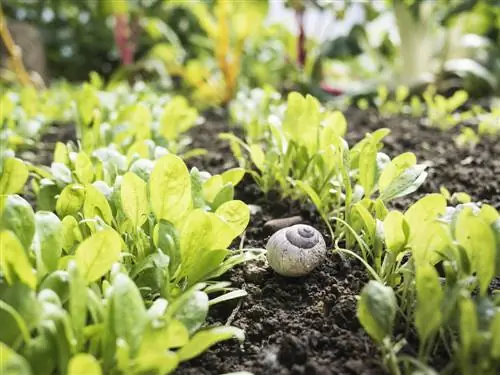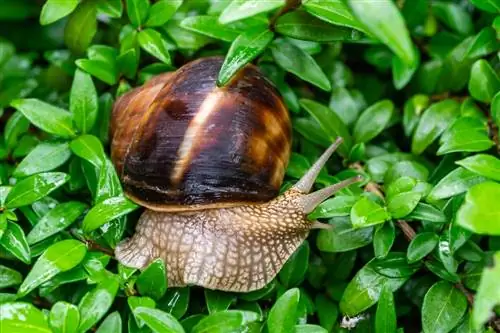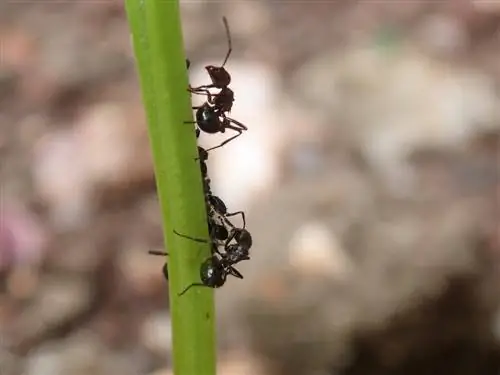- Author admin [email protected].
- Public 2023-12-16 16:46.
- Last modified 2025-06-01 06:02.
The eating habits of snails are a reflection of their lifestyle. Slugs leave behind a picture of misery. Shell snails clean up and eat away the waste. Find out here what snails eat and what they don't. Clear tables illustrate important differences.
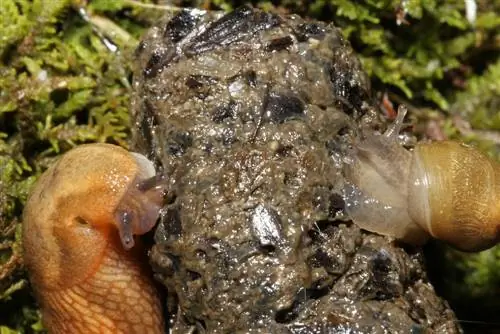
What do snails prefer to eat?
Snails eat different things depending on the species: slugs prefer fresh greens such as lettuce, cabbage or strawberries, while shell snails eat dead plant remains, rotten grass and carrion. Both avoid plants with a high content of tannins/bitter substances such as artichokes, rhubarb or lavender.
- Slugs eat fresh greens, such as lettuce, cabbage, potato leaves, parsley, basil, horseradish and strawberries.
- Snails with houses prefer to eat decomposed plant remains, rotten grass, sludge, fungal threads, rotten fruits and carrion. Shell snails do not eat fresh greens.
- Snails do not eat vegetables and flowers with thick-fleshed leaves or lots of tannins/bitter substances, such as artichokes, chard, garlic, rhubarb, onions, cyclamen, begonias, coneflowers, lavender, sea lavender.
What do snails eat? - Table
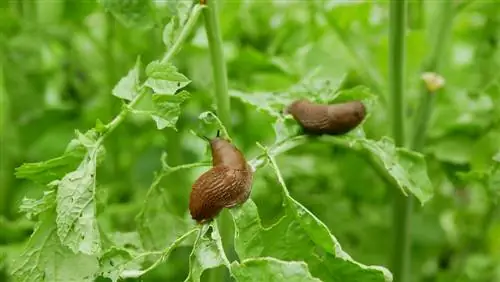
Nudibranchs love to eat our vegetables
Destructive feeding habits make slugs a feared garden pest. As omnivores, the beasts mercilessly eat what hobby gardeners have lovingly planted in beds and containers. Their invasive appearance, of course, hides the fact that not all snails are the same. The harmless counterpart to eating slugs are shell snails that are worth protecting. The question arises: What do snails with houses actually eat in contrast to slugs? The following table provides a compact overview:
| Nudibranchs | Shell snails |
|---|---|
| Salad | rotten grass |
| cabbage | wilted plant leaves |
| Carrot leaves | Mushroom threads |
| Potato leaves | decomposed plant residues |
| Fruit vegetables | rotten fruit |
| Horseradish | Mulm |
| Basil, parsley | Cadaver |
| Strawberries | |
| young petals | |
| Tagetes |
A special form of slugs are the predatory snails, which spice up their diet in a scary way. Snails (Limacidae), such as the well-known tiger snail (Limax maximus), engage in cannibalism. Where the opportunity arises, other slugs are devoured alive. Despite this diet, which takes some getting used to, predatory snails are now considered welcome beneficial insects in natural gardens.
The video below is full of informative hints and tips about what snails eat and how you can get rid of the pests:

What do snails eat in winter?
In autumn, falling temperatures put an end to the big eating. Before winter sets in, all snails disappear and reappear in spring. Slugs crawl into frost-free layers of soil to overwinter. The molluscs have no resistance to the bitter frost and die. The frost-resistant egg clutches from which young snails hatch just in time for the start of the new gardening season are more robust.
Shell snails also stop eating in winter. Because snails with houses cannot hide in the ground, they have developed an alternative survival strategy. Before the first frost, they look for a sheltered niche in the garden or forest. There the snails close their house with a lime lid.
Excursus
Slimy water police - snails in the pond and aquarium
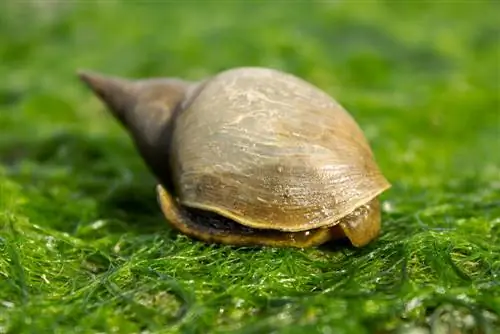
Pond snails prefer to eat algae, dead plant parts and excess fish food
When you see bladder snails (Physidae), pointed mud snails (Lymnaea stagnalis) and other aquatic snails, concerned pond owners ask themselves: What do snails eat in the pond? A quick look at the menu gives the all-clear. Snails in garden ponds prefer to eat algae, carrion and dead plant remains. Mulm, fish droppings and excess fish food are also cleaned up. Marsh snails (Viviparidae) are even able to filter plankton and suspended algae from the water. With these food preferences, the busy aquatic inhabitants make an important contribution to crystal clear water of premium quality. Knowledgeable aquarists appreciate this and introduce useful aquatic snails into the aquarium.
What don't snails eat?
Snails have an aversion to plants that are full of tannins, bitter substances and essential oils. Numerous species produce these ingredients in large quantities in order to keep the slimy greed maws away from their throats. Many plants develop thick, leathery or hairy leaves as an ingenious defense strategy against snail damage. The following table names vegetables, herbs and flowers that experienced hobby gardeners have certified as slug-free growth:
| Vegetables | Herbs | Flowers |
|---|---|---|
| Artichoke | Comfrey | Aster |
| Chicory | Goose cress | Cyclamen |
| Endive | ragwort | Begonia |
| garlic | Chamomile | Hardworking Lieschen |
| Chard | Peppermint | Nasturtium |
| Radish | Oregano | Lavender |
| Rhubarb | Sage | Coneflower |
| Asparagus | Thyme | Sea Lilac |
| Onion | Lemon balm | bleeding heart |
Furthermore, snails lose their appetite for all kinds of ornamental grasses and most ferns. Because the insatiable pests also ignore moss, natural gardeners use liverwort extract against snails.
The culinary dislikes of shelled snails in the garden and forest can be summarized in one sentence: Snails with shells do not eat fresh greens in the wild. This set of experiences does not apply to shell snails, which live under controlled conditions in the terrarium and have to eat whatever is on the table.
Tip
Snails prefer to eat delicate plant leaves. Experienced hobby gardeners plant young vegetables with a snail collar as ideal protection against snails in the garden. This precaution also applies to young anti-slug plants until they have developed a sufficient amount of tannins and bitter substances or eat-resistant leaves.
What do snails like to eat in the terrarium
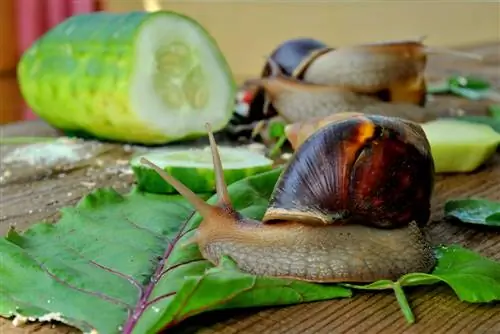
The food buffet for snails is quite diverse
Glossy snails (Zonitidae), glass snails (Vitrinidae), Roman snails (Helix pomatia) and other snail beauties have no objection to a life behind glass, as long as the conditions are right. One of the mainstays of successfully keeping snails in a glass house is a varied, species-appropriate nutritional plan. The following tips get to the heart of what snails like to eat in the terrarium:
- Treats: cucumber, clover, oatmeal
- Vegetables: Kohlrabi leaves, carrots, radishes, lettuce, (also wilted), boiled potatoes
- Fruit vegetables: Tomato cutlets, eggplant (overripe pieces are best eaten up)
- Fruit: crushed berry or fruit tree fruit (soft and rotten or fresh)
- Herbs: parsley, basil
- Wild plants: nettle leaves, dandelions
- Supplementary food: fresh autumn leaves, eggshells as a lime source
Snails in terrariums are demanding and have an aversion to monotony. Changing daily specials are therefore the key if you want to feed your pampered children he althily. On the other hand, if you serve cucumber, clover or oatmeal every day, snails will go on hunger strike out of boredom until a new treat is served.
What do baby snails like to eat most?
Baby snails do not differ from their snail parents when it comes to their food preferences. When they are born as small slugs, they prefer to eat tender lettuce leaves, fine dandelion leaves and white clover leaves. Because the mini snails hatch at the same time as sowing time, seedlings and seedlings in the bed are highly sought after by the insatiable young people.
Small snails with houses are not particularly keen on fresh plant leaves or strawberries. Rather, they imitate their parents and look out for wilted leaves, fallen petals, rotten mushrooms and similar plant remains. In the terrarium, mini snails enjoy pieces of cucumber or tomatoes.
Snails eat lettuce - what to do?
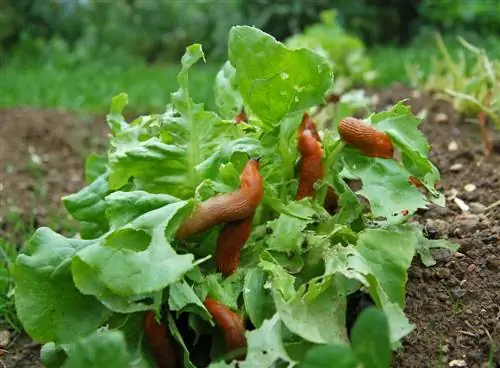
Salad is apparently snails' favorite food
Snail damage is the biggest and usually only pest problem in the lettuce bed. This is hardly surprising, as tender lettuce is at the top of the menu for insatiable snails. In their greed for the treat, slugs ignore numerous control methods that achieve best success in other beds. So what to do?
The best measure against snails on lettuce is a snail fence. Specialist retailers have proven models for every budget. The cheapest solution is a plastic snail fence that keeps the voracious rabble away from your lettuce bed for a season. The premium solution is a fence made of galvanized steel with a significantly higher purchase price. The investment pays for itself quickly because the stable snail fence usually lasts the gardener's lifetime.
Snails eat strawberries - what to do?
To protect against snail damage to strawberries, nature-oriented hobby gardeners use their bag of tricks. The secret to success in the slug-free strawberry bed is straw. A layer of straw acts as a barrier for approaching snails. Positive side effect: Mulching with straw prevents direct contact of strawberries with soil and thus prevents rot.
Frequently asked questions
What do predatory snails eat besides snails?
Predatory snails are omnivores with a tendency to cannibalism. If there isn't a tasty slug snaking past, predatory snails like to eat tender plant leaves, aromatic mushrooms or algae. Predatory snails like to eat their fill of eggs laid by slugs and Spanish slugs.
What kind of snails do hedgehogs eat?
Hedgehogs are crepuscular and nocturnal insect eaters. The cute spiny animals don't disdain a fat snail either. All kinds of slugs are eaten, such as garden slugs, Spanish slugs and predatory snails. Because shell snails retreat into their houses when threatened, hedgehogs bite out their little teeth on these snails. Understandably, snails and other snails with houses are not on the hedgehog menu.
Snails eat basil - what to do?
In the tough battle with snails around your basil, you can be ahead with a combination of natural control methods. Mulch the root disc with sharp materials such as grit, sawdust or pine needles. Sprinkle some coffee grounds over the mulch every two to three weeks. When mixed with sage, thyme, mint and marigolds, snails will avoid your basil. The best protection for the herb bed with basil is a snail fence made of plastic or stainless steel. Ideally, you should plant individual basil with a snail collar.
What do snails eat in the forest?
Snails are masters at adapting their feeding habits to local conditions. Because delicious lettuce and delicious basil cannot be found in the forest, slugs turn their attention to other green plants with tender, young leaves. Some species of snails specialize in algae and lichens. Mushroom snails eat mushrooms with enthusiasm. Shell snails remain true to their reputation as beneficial insects and eat plant waste, carrion and sludge.
Which is the largest native snail?
The largest native snail is a predatory snail from the snail family. A tiger snail grows up to 20 centimeters long. The largest shell snail is the Roman snail, which boasts a shell 5 centimeters in diameter. Compared to the world's largest snail, tiger snails and snails are left behind. With a length of up to 65 centimeters, the Ritterhelm sea snail is a true giant that is native to the coasts of Australia.
Tip
Are voracious slugs in your garden making your life hell? Then hire a brigade of feathered bodyguards for your ornamental and crop plants. Runner ducks like to eat fat snails and also eat the eggs with great pleasure.



